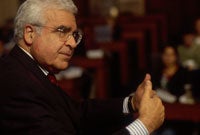Post Date: April 3, 2006
SCHOLARLY PURSUITS: The following is a summary of a recent law review article by Professor Arthur Miller. Summaries of other articles by HLS faculty members can be found on the Recent Faculty Scholarship web page.
THOUGH IDEAS FUELED the progress of the 20th century, scholars and the judiciary have been complacent about protecting the rights of idea originators. The result is an “inconsistent and incoherent” landscape offering little protection to idea generators, according to Professor Arthur Miller in Common Law Protection For Products Of The Mind: An ‘Idea’ Whose Time Has Come, in the January 2006 Harvard Law Review.
Even though copyright and patent protection have roots in the Constitution, many ideas have been specifically excluded from protection by statute and precedent. In his article, Miller breaks down each of the variables that have contributed to the inconsistency and incoherence of idea protection, and offers a new approach. Miller argues that state rather than federal courts are the likely laboratory for a new idea protection regime, raising myriad federalism issues because of the possibility of federal preemption.
Current jurisprudence draws on existing copyright, patent, contract, trade secret, and misappropriation statutes and precedents, as well as on common law. Courts are hesitant to provide legal protection to something as intangible as an idea, and Miller takes readers through the web of current doctrine that hinges primarily on a two-pronged test of an idea’s characteristics: “concreteness” and “novelty.”
Under current law, Miller says, an idea must be “concrete” in order to qualify for protection, and yet courts are reluctant determine what is concrete. Nevertheless, he points out that in other kinds of cases courts award compensation not only for such vagaries as “emotional distress and loss of consortium, but also for even more elusive injuries involving privacy, publicity, and elevated risks and fear of cancer.”
The relative novelty of an idea can create a more difficult barrier than concreteness. Here too, courts have set a high, yet inconsistent bar.
These are the wrong tests to apply to idea cases, Miller asserts. “It is time to scrape the doctrine clean and lay bare its inner workings so that its objectives are in plain view for judicial consideration and application.” Courts should consider whether a judgment in favor of “idea plaintiffs” would stifle more innovation. The second primary consideration should be whether the defendant benefited from an idea to which she wasn’t entitled.
Miller acknowledges that his alternative framework is probably even more vague than the current standards. The benefit is that courts would retain the flexibility to judge cases on individual merit, but with a focus on the right issues. Miller addresses possible objections and issues, such as whether creativity would suffer, who actually adds value (and is entitled to compensation), and whether a wave of sham litigation will result.
Is it too late to create a body of law with a focus on the broader consequences of idea protection rather than the inherent characteristics of the particular idea in question? Miller doesn’t think so. “American intellectual property law properly is recognized as a work in progress. So even though the task of changing state idea law may be arduous… I am optimistic that the American legal system can meet the challenge and develop a more equitable and realistic law of ideas.
Miller has been fascinated by copyright, patent and idea protection since his days as a law student at Harvard. He began the article as a second-year student in 1956.
